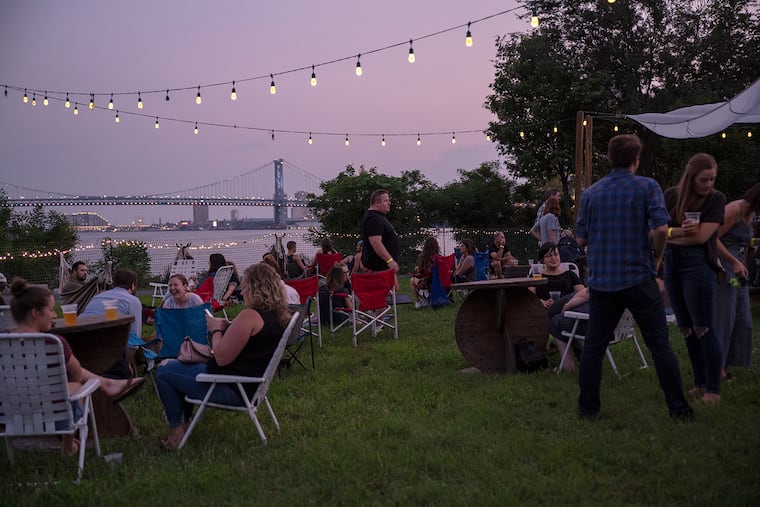Parks on Tap is traveling again, starting with a 5-park tour
Sure, there's soft pretzels with mustard and Tajín-sprinkled watermelon slices, not to mention beers, cocktails, and rosé. But the best part of Parks on Tap remains the parks themselves.

Philly is swimming in parks. They come in all sizes, from sprawling expanses that go for miles, to pocket parks tucked between rowhouses. For four glorious seasons before 2020, that diversity was showcased via Parks on Tap, the traveling beer-garden series. The partnership between the Parks & Recreation department, Fairmount Park Conservancy, and FCM Hospitality (the same group behind Morgan’s Pier and Harper’s Garden) launched in 2016 with a 14-park lineup that grew to 23 parks by 2019.
The pandemic didn’t put an end to Parks on Tap, but for two years, it was confined to just one or two locations. The program has resided at Fairmount Water Works for most of this summer, as well.
But starting next week, the series heads back on the road. It kicks off a five-park tour Aug. 31, changing locations each week until the end of October. Sure, there will be soft pretzels with mustard and Tajín-sprinkled watermelon slices, loaded hot dogs and caprese pasta salads, not to mention beers, cocktails, and rosé. But the best part of Parks on Tap remains the parks, so The Inquirer spoke with Parks and Rec’s Marc Wilken to learn more about them.
Aug. 31 - Sept. 5: Penn Treaty Park
Neighborhood: Fishtown
History: Opened in 1894, this riverfront park is said to be where the chief of the Lenape, Tamanend, and William Penn entered into peace treaty in 1683, under an elm tree that’s long gone (but whose descendants are planted elsewhere in the area). A statue of Billy Penn holding a scroll nods to that lineage.
What it’s best known for: Its views of the Ben Franklin Bridge, according to Wilken: “It’s just a place where people can really can escape the city, the hustle and bustle, and unwind.”
North Delaware Avenue & Beach Street, facebook.com/PennTreatyPark
Sept. 7-11: Clark Park
Neighborhood: Spruce Hill
History: Named for the founder of the Union League and first First National Bank president Clarence H. Clark, this wedge of land in West Philly was a public dumping ground before being transformed into a park in the mid-1890s. Mill Creek used to flow through the site until it was covered up and repurposed as a sewer line. The creek used to supply a pond; you can see its edges it what’s now called “the bowl.”
What it’s known for: All of the activities, Wilken says. “Everyone takes that park and makes it their own, whether it’s LARPing or people playing chess or the Shakespeare [in Clark Park] series and the farmers market. There’s just so much going on there, it’s such an amazing energy.” Shakespeare happens in the bowl, but look for another literary figure while you’re there: The first statue of Charles Dickens, cast in 1891, was relocated to the park in 1901.
4300-4398 Baltimore Ave., friendsofclarkpark.org
Sept. 14-18: Columbus Square
Neighborhood: East Passyunk
History: This recently renovated park has been well used since it opened in 1874 as Passyunk Square. (It was renamed in 1954, then again in 1983, and again in 2020.) In the 1890s, it hosted summer concerts. In the 1930s, it was home to antifascist rallies. It’s seen boccie courts and marbles tournaments, ballet and opera performances, Shakespeare in the Park, and lots of recreational sports teams over the decades. Today, it’s home to a boisterous playground and dog-park scene.
What it’s known for: “The park has so many different rooms, if you will. There’s the dog-park piece that’s been a tremendous success, but also spaces where people can just be in the shade and read or eat and relax.”
13th and Wharton Streets, columbussquare.org
Sept. 21-25: Matthias Baldwin Park
Neighborhood: Franklintown
History: In the scheme of Philly parks, this one’s a youngster. It was commissioned in 1981 through the city’s One Percent for Art program and designed by artist Athena Tacha, who conceived the park as an “environmental sculpture.” Look for the sculptural aspects up close in the park’s curved terraces that overlap and converge at points marked by vertical rocks.
What it’s known for: Possibly for being overlooked. “For the most part, people just walk through the park. It’s not really a place you necessarily hang out in all day, so when it becomes Parks on Tap, we create a whole new activation that normally isn’t there, so it really transforms the park,” Wilken says. “It’s this little hidden gem. If you don’t pass by it, you may miss it.”
423 N. 19th St.; baldwinparkphilly.org
Sept. 28-Oct. 2: Schuylkill Banks
Neighborhood: Center City
History: This area along the Schuylkill under the Walnut Street Bridge has far less formal boundaries than its Parks on Tap counterparts. It still has a story, though. The Schuylkill River Trail today teems with runners, bikers, dog-walkers, and more, but the riverside was empty in the postindustrial era, which overwhelmed the Schuylkill with trash and pollutants. (That’s not the case today, despite perceptions.) In the ‘90s, neighbors and nonprofits led the charge to clean up and preserve the riverfront, creating a park and a paved trail, which opened in 2000.
What it’s known for: It’s Parks on Tap’s flagship spot and first location, in 2016. “There are not really any amenities along the Schuylkill Banks — there’s not really anywhere to really grab food and drinks. So instead of bringing your own stuff, you have the convenience to just pop over and show up,” Wilken says. “To add the amenities that aren’t normally there — more furniture, food and drinks, the lights — it really just enhances the experience and makes it even more inviting for folks to come and spend time there.”
Walnut Street and the Schuylkill, schuylkillbanks.org